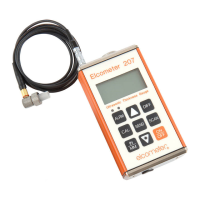15
5 CALIBRATION
In order for the gauge to make accurate measurements, it must be set to the correct sound-velocity for the
material being measured.
Different types of material have different sound-velocities. For example, the velocity of sound through steel
is 5918 m/s (about 0.233 in/µs) and the velocity of sound through aluminium is 6350 m/s (about 0.248 in/
µs).
If the gauge is not set to the correct sound-velocity, all of the measurements the gauge makes will be
erroneous by some fixed percentage.
There are three methods of calibrating your gauge:
K
NOWN
THICKNESS
CALIBRATION
: This is the simplest and most commonly used calibration procedure -
optimising linearity over large ranges. One-point calibration is carried out using a known thickness.
K
NOWN
VELOCITY
CALIBRATION
: The sound-velocity of the material being measured is entered directly into
the gauge.
Note: Known thickness calibration must be performed on material with the paint or coating removed. Failure
to remove the paint or coating prior to calibration will result in a multi-material velocity calculation that may
be different from the actual material velocity intended to be measured.

